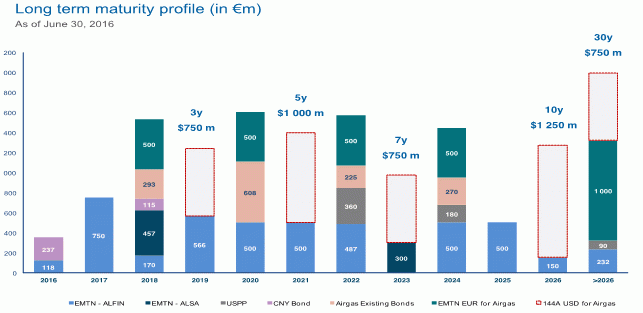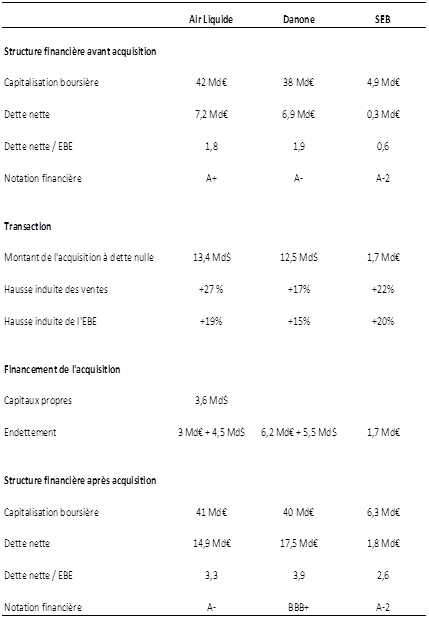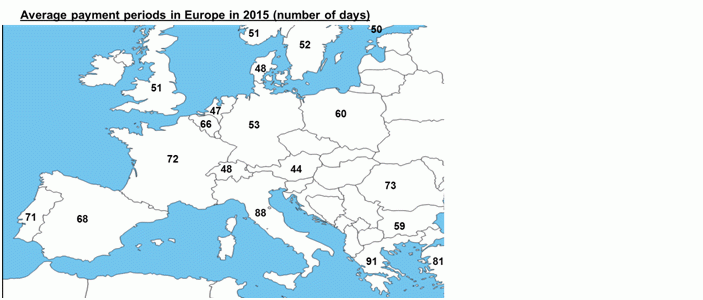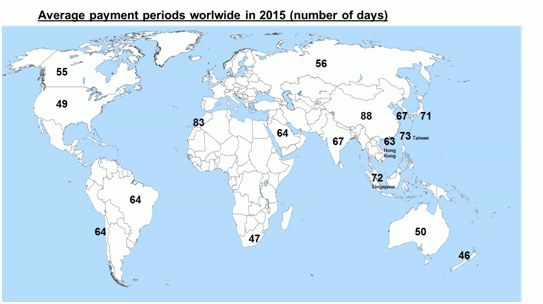Letter number 100 of January 2017
- TOPIC
- STATISTICS
- RESEARCH
- QUESTIONS & COMMENTS
- NEW
News : How Air Liquide, Danone and SEB financed their 2016 acquisitions?
In 2016, these three groups carried out major external growth operations with Air Liquide’s acquisition of Airgas (for $13.4bn), Danone’s acquisition of WhiteWave (for $12.5bn) in the USA, and SEB’s acquisition of WMF in Germany (€1.7bn). Each of these acquisitions represented around one-third of these group’s market capitalisation and enabled them to at least double their size in the USA and in Germany. Given their size in both absolute and relative terms, external financing had to be secured for these acquisitions.
The way this type of financing is secured is now well-established. Firstly, before announcing the acquisition, the acquiring group negotiates a bridge loan with banks with which it enjoys very close relationships, which is only put in place once the deal has been signed and is only drawn down once the conditions precedent to the acquisition have been lifted, i.e. in practice, mostly after anti-trust approvals have been obtained. Then, the bridge loan is gradually paid back using the proceeds from market transactions intended to refinance the acquisition over the long term, such as share issues, placement of listed debt or negotiable instruments (bonds or private placements).
Unless, like Danone, the group sets up its bond financing before getting the green light from the competition authorities, which would be a few months before the acquisition is actually completed, and paying the sellers. This order of doing things is made possible by including a Special Mandatory Redemption (SMR) clause in the bond issue contracts enabling the acquirer, if the acquisition falls through, to repay this financing immediately at an agreed price of 101% of the issued amount. The increasingly widespread use of SMR clauses is evidence of a bond market that is favourable for issuers. It gives the acquirer a way out if it does not wish or is unable to meet the demands of the anti-trust authorities.
So, once the bridge loan has been paid back, we have a debt structure mainly made of market-based debt which is how most large groups do it today. On 30 June 2016, 43% of Air Liquide’s debts were bank debts. Its $13bn bridge loan was put in place at the time of the actual acquisition of Airgas in late May 2016, and was only reduced by the proceeds from the euro bond issue in early June (€3bn), pending a dollar bond issue ($4.5bn) and a capital increase (€3.3bn) in September. Once the dollar bond issue had been completed, the share of bank debt fell to 8% compared with 92% for market-based debt and it fell to 0% once the capital increase had been completed. Danone and SEB behaved in a similar manner. For large groups, banks generally provide bridge loans pending a market transaction or asset disposals and letters of credit or of guarantee. And it’s the market (shares, bonds public or private placements and equivalents) which provide long-term financing.
It is obvious that as soon as a bridge loan is put in place, it is in the company’s best interests to get its long-term refinancing operations off the ground as soon as possible, in order to limit the liquidity risk and avoid the situation experienced by Lafarge when it acquired Orascom in December 2007. Lafarge was forced, at the very worst of times (February 2009), to carry out a financial rescue operation, because its bridge loan was due but the group had been unable refinance on the financial markets as would have been the case in normal times, as the financial markets were in the process of disintegrating.
Granted in November 2015 for two years, the Air Liquide bridge loan was drawn down in late May 2016 at the time of the actual acquisition of Airgas and repaid in full in October 2016 following completion of the capital increase.
For Danone, the bridge loan was not drawn down because it was refinanced before the actual acquisition of WhiteWave (which should take place in the first quarter of 2017) by way of two bond issues (one in dollars and one in euros) in late October 2016. These were divided into several tranches of 2, 4, 6, 8 and 12 years in euros and 3, 5, 7 and 10 years in dollars. The same thing happened for the Air Liquide bond issue (10 tranches with maturity dates between 2018 and 2046).
Why? Because bonds listed on the international market are redeemable at maturity. In order to avoid having to handle a €6.2bn repayment in any given year, Danone’s €6.2bn bond was split into several tranches maturing at different times. Given the amount of funds being raised, each tranche can have a minimum unit value of €500m or $750m, which is standard on the bond market, and reasonable liquidity, likely to attract investors.
A more even spread can also be achieved by postponing maturities of new issues to years when few bonds will be maturing, as illustrated in this figure published by Air Liquide, where the maturities of US bonds (in light grey) were set for 2019, 2021, 2023, and 2026, years in which only small amounts will have to be repaid:
Even though the interest rate risk may be partially hedged on future debt issues [1], Danone cannot really be criticised for the speed of its refinancing, which enabled it to obtain, in late October 2016, €6.1bn at seven years with an average interest rate of 0.55% and $5.5bn at seven years with an average interest rate of 2.45% before cross currency swap. Interest rates have risen since then and if Danone wanted to raise debt today, it would have to do so at much higher interest rates.
The foreign exchange risk that Danone and Air Liquide conserve by financing part of the acquisition of US assets with debt in euros that is not hedged using swaps, is not public. Even though taking out debt partially in euros in order to reduce their cost of debt is tempting, it would impact the group’s foreign exchange risk for years. For the moment, this strategy has paid off because the dollar has risen against the euro since the financings were put in place (by 3% and 6% respectively).
Foreign exchange risk was obviously not an issue for the Lyon-based SEB group because its target was German.
Since SEB’s refinancing needs were eight times less (€1.7bn), the company was able to look at much smaller segments of the financial market, and even create a new one with the issue of a €150m ORNAE bond (bond redeemable in cash or in existing shares), taking advantage of the scarcity of new convertible bond issues with investors that are seeking this type of placement and that are prepared to accept a yield to maturity of -0.42%. More details on this product are provided in our new Comments section at the end of this newsletter.
SEB’s refinancing also includes the issue of a €800m Schuldschein[2] in four tranches of 3, 5, 7 and 10 years. This is a product that has already been issued by SEB in the past so it has built up an investor-base that is familiar with its bond issues.
* * *
All in all, these three financing transactions show once again that investors are prepared to support industrial strategies that seem to make sense to them, implemented by groups that have, over the years, demonstrated their operational excellence, their ability to successfully integrate new acquisitions and that have exercised caution by putting in place debt facilities that are not drawn down until D-Day. For example, we note how Air Liquide was keen, notwithstanding this major acquisition, to keep room for manoeuvre as shown by its rating which remained in the A category, thanks to a €3.3bn capital increase and notwithstanding investors in dollar debt that were prepared to provide it with... $25bn, when it was only looking for $4.5bn.
[2] For more on this product, see chapter 21 of the Vernimmen.
Statistics : Payment periods
Euler Hermes, the worldwide credit insurance and debt collection group, regularly publishes statistics on average payment periods around the world.
In its most recent publication, Euler Hermes estimates that worldwide, the average period between delivery and effective payment by the customer is 64 days, a figure that has been stable since 2010 and that should remain so for 2016. These are estimated payment periods, not the theoretical payment periods set out in contracts.
This average conceals major disparities, with 25% of customers paying at less than 32 days and 25% waiting at least 90 days before paying what they owe. Unsurprisingly, the champion slow payers, and the highest credit risk for suppliers, are Greece (which is improving at 91 days), China at 88 days (getting worse) and Italy, also at 88 (improving). The best behaved customers are to be found in Austria (44 days and getting better), New Zealand (46 days) and the Netherlands (47 days, also making progress).
Source: Euler Hermès December 2016
Research : Human capital and financial distress
With Simon Simon Gueguen, lecturer researcher at Paris-Dauphine
When a company is financially distressed, i.e. when it is finding it difficult to meet its financial obligations to its creditors and there is a not insignificant risk of bankruptcy, it suffers economic consequences. For example, some customers and suppliers would prefer not to do business with such a company because of the counterparty risk. Another consequence is the impact on the company’s human capital. Financial disstress makes a company a lot less attractive to prospective employees. This is one of the costs of bankruptcy that manifests itself before the (potential) bankruptcy and that has to be set off against the tax advantage of debt.[1]
The theory behind this effect of financial distress has been studied[2], but its empirical measurement is not easy to determine. The technical difficulty that we encounter, that of two-way causality, is one that is very common in this sort of analysis. On the one hand, financially distressed companies are less attractive to prospective employees (which is what we want to establish empirically) and on the other hand these companies also advertise fewer job opportunities.
This month we look at an article[3] which uses a very comprehensive sample of job offers and job searches (taken from an online job search platform) which enables us to get around this difficulty.
The article successively answers three academic questions.
What is the quality of job seekers’ perception of financial distress?
The study covers responses to a survey carried out by the platform, on jobseekers’ perception of the financial health of companies (rated from 1 to 5). The results confirm that jobseekers are able to (partially) perceive the financial health of companies. The score given is substantially lower when the company is financially distressed, which is measured by the price of 5-year credit-default-swaps (CDS[4]).
How does financial distress affect job seekers?
This is the main issue raised in the article. The analysis covers a sample of 78 companies in the financial sector of the US market between April 2008 and December 2009. This sample was chosen because of the major changes in the financial health of these companies over this period. Brown and Matsa analyse the relationship between the company’s risk of defaulting (always measured by price of CDS) and the number of applications received. Because this was such a comprehensive sample, it was possible to include a fixed effect per job advertised. So, they were able to measure the effect of a change in the company’s financial health and the attractiveness of the job advertised, and to avoid the problem of two-way causality. Overall, an increase in the CDS price of 1,000 base points (indicating a substantial deterioration in financial health) leads to a drop in applications of around 20%.
This effect is not linked to a possible decline in compensation offered. In this sample, companies that were financially distressed tended to offer better compensation (to make up for this distress).
What consequences does financial distress have on a company’s human capital?
In addition to the results they obtained, Brown and Matsa show that applicants’ sensitivity to financial health is higher for positions that require more qualifications. Moreover, at distressed companies, the size of the whole workforce is reduced (11% reduction in headcount for a 1,000 base point increase in CDS price), while the number of jobs advertised remains stable. The combination of these two effects is compatible with the idea of a decline in the ability to hold onto human capital.
These results provide empirical confirmation of the economic consequences of financial distress. Over and above commercial problems (relationships with customers and suppliers) or financial problems (difficult to obtain financing even for solid projects), financial distress has a negative impact on the human capital of companies. Once the whole process has been set in motion, it is very difficult to reverse it!
[1] For more see chapter 33 of the Vernimmen.
[2] See for example J. Berk, R. Stanton and J. Zechner (2010), Human capital, bankruptcy, and capital structure, Journal of Finance, vol. 65-3, pages 891 to 926.
[3] J. Brown and D.A. Matsa (2016), Boarding a sinking ship? An investigation of job applications to distressed firms, Journal of Finance, vol. 71-2, pages 507 to 550.
[4] For more on CDS, see chapter 50 of the Vernimmen.
Q&A : Translation differences
Translation differences result from fluctuations in exchange rates which adjust the local value of payables and receivables in foreign currency.
Under IFRS, foreign payables and receivables are converted and recognised at the closing exchange rate on the date on which the accounts are closed. Accordingly, these amounts will differ from initially recorded transactions, if the currency of the payable or receivable has varied from the local currency since then.
Let’s take a receivable of £100, initially booked at €140. Since the exchange rate on the closing date was €1.3 for £1, the receivable is only worth €130 and this is the amount at which it must now be recognised on the balance sheet. In order to maintain a balanced balance sheet, a translation difference (an unrealised exchange loss of €10) needs to be recognised on the asset side of the balance sheet. Furthermore a €10 risk provision is recorded as a liability on the balance sheet and as well as a corresponding risk provision on the income statement.
Here’s another example with a payable of $100, initially booked at €90 and which at year-end is only worth €85. Its book value is only €85 so a €5 translation difference (an unrealised exchange gain) is recorded on the balance sheet, on the equity and liability side, in order to ensure equilibrium.
These currency translation differences should not be confused with those found in consolidated financial statements which result from the different exchange rates used to convert items on the balance sheets and income statements of consolidated subsidiaries that keep their accounts in local currencies[1].
From a financial point of view, unrealized exchange losses must be subtracted from the asset side and from the risk provision on the balance sheet. Unrealized exchange gains must be added to equity. Accordingly, translation differences disappear from the balance sheet. Debts and receivables remain at market value on the basis of the exchange rate on the date on which the accounts are closed (and not the rate initially used). The risk provision in the P&L statement should be deducted from sales.
[1] For more on this, see chapter 6 of the Vernimmen.
New : Comments posted on Facebook
Regularly on the Vernimmen.com Facebook page[1] we publish comments on financial news that we deem to be of interest. Here are some of the comments published over the last month.
Linde and Praxair have announced their agreement in theory to a merger of equals to form the world leader in the production of industrial gases, ahead of Air Liquide, with a share of the world market that will reach 42%.
A great deal of care and attention has gone into determining the corporate governance of the new group: the CEO will be Praixair’s CEO, the non-executive chairman will be Linde’s, the financial director will be Praxair’s and the new group will be called Linde. The Munich and Danbury (Connecticut) headquarters will be kept and the new group’s general manager will not have to move because he’ll be staying on in Danbury. A decision has not yet been taken as to where the legal headquarters will be located, but it will be in one of the European Economic Space countries (but not Germany).
The new group will be listed in New York and in Frankfurt and the share capital and board of directors will be split 50/50 between former shareholders and directors of Linde and Praxair.
It is unlikely that the merger will be completed in under a year given that lengthy negotiations with anti-trust authorities will have to be held in view of the new group’s large market share. So at least one year of immobility and disposals are on the cards for strengthening competitors. Then, we wish them the best of luck in managing a group with the corporate governance set-up described above, which seems to aim more at stroking the egos of the various parties rather than providing the new group with manoeuvrability.
So it’s no surprise that the Linde share price fell by 4% when this plan was announced, even though under the terms of the merger, Linde shareholders are supposed to be getting a little premium of 5%. Praixair’s share price has also dropped by 4%. Perhaps this is because investors have not yet forgotten another major American-German merger, that of Chrysler-Daimler Benz, which was both an industrial and a financial disaster, partly as a result of cultural differences which were seriously underestimated.
∞∞∞
The Financial Times reports on the LBO fund being raised by CVC, one of the main European private equity firms, which could raise a new fund in the first half of 2017 of between €12.5bn and €15bn for investor demand in the region of €25bn to €30bn.
Demonstrating the law of supply and demand, the financial terms for investors subscribing to the fund will not be as good as usual for them and will be better than usual for the fund manager. There will be no reduction of management fees for the first investors to subscribe and the hurdle rate will be reduced from 8% to 6%, giving the fund managers a 20% share of capital gains made by investors above this threshold. Investors in the CVC fund will be able to console themselves with the knowledge that historically, CVC has been one of the best performing private equity firms and for those who invested in the Advent fund which raised $13bn a few months ago, the fact that the trigger threshold was reduced to….. 0%.
With an expected average rate of return on the listed shares of 7% in Europe (source Associés en Finance), the 8% threshold is already well below that an investor in an LBO fund would be entitled to require (around 12 to 15%), given the risk of the leverage effect that is specific to LBOs and to the illiquidity of this type of investment. The level of this threshold is merely evidence of a well-established academic fact, i.e. that LBO fund managers are the ones who get the lion’s share of excess returns.
The reduction of this threshold is the consequence of rising asset prices (in 2016, the average multiple for acquisitions by LBO funds exceeded 10x EBITDA for the first time), as a result of falling costs of capital (the market risk premium has returned to is average level since 2002) which more or less mechanically reduce expected future returns. But it is also the result of the fact that LBO funds’ debt to equity ratios are much lower than at the time of the peak in 2007, and that there are very few targets that are sufficiently large.
∞∞∞
In this week issue of the magazine Option Finance, there is an interesting interview of Philippe Marien, Deputy CEO of Bouygues who states, in relation to IFRS 16 the new accounting standard on operating leases: ". . .we are faced with a considerable workload to carry out the identification and evaluation of our leasing contracts and a significant change in our financial indicators such as EBITDA, which will be increased by rent expenses, requiring significant explanatory efforts for financial analysts. This change in methodology combined with a large share of estimates will likely reduce account comparability between groups.
In addition, managers and market participants (analysts, investors...) essentially want to know the future cash flows of companies: operational cash flow, investment and financing flows. Adding more and more non-cash items as requested in IFRS 16 disconnects accounting from the needs of many players, results in restatements and the multiplication of non-accounting adjusted indicators. "
Since 2010, we have kept on denouncing this project, which will lead to the recognition of operating leases as financial leases by putting right of use on the asset side of the balance sheet and a debt representing the present value of the rents to be paid on the liabilities side. Only the non-adoption of this standard by the European Union may defeat its implementation from 2019. EFRAG is investigating to make its recommendation to the EU and it is high time for companies to mobilize and say high and strongly what they think of this standard as Philippe Marien does.
For more on this topic, have a look on the Vernimmen.com Newsletter issues of December 2010 and October 2013 and on chapter 7 of the Vernimmen.




